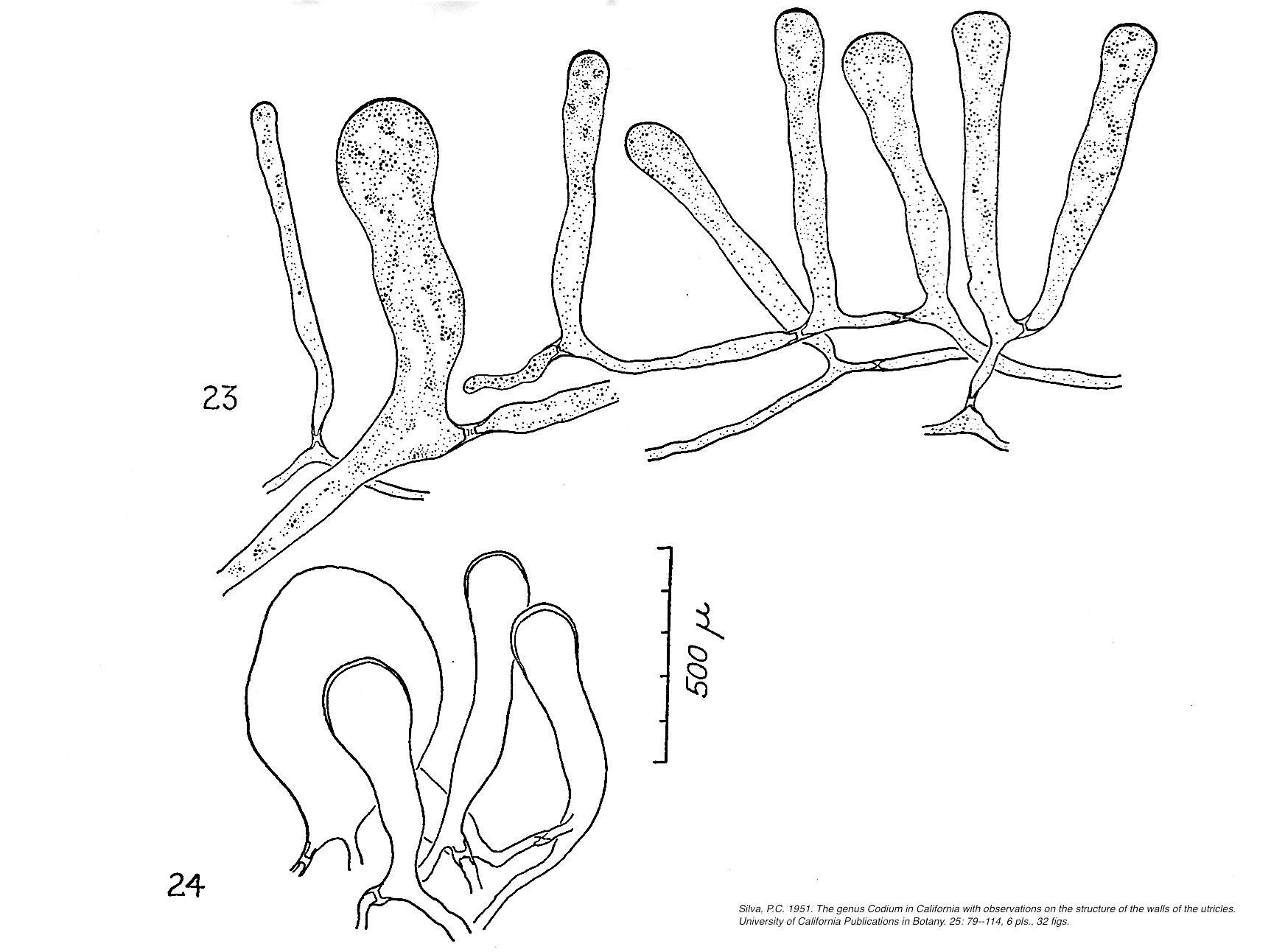Codium dawsonii
P.C. Silva, Pedroche, Chacana & K.A. MillerKey Characteristics
- Groups of olive-green, dichotomously branched, cylinders
- Flattened or compressed at branching junctions and at tips
- Texture dense and spongy
Image Gallery (click for more)
Database links
- Blue markers: specimen records
- Yellow marker: type locality, if present
- Red markers: endpoints of range from literature
View map from the Consortium of Pacific Northwest Herbaria
Notes: A near island endemic. Also collected at Isla Coronados and Isla Guadalupe in Mexico. Reported from mainland Mexico ten miles west of Punta Malarrimo, Bahía Viscaino.
Status: This species has been confused with Codium cuneatum Setchell & Gardner, a Gulf of California species. Codium cuneatum has been collected infrequently in southern California, chiefly from Mission Bay, San Diego Co. Preliminary DNA analysis has shown that C. dawsonii is distinct from Gulf of Mexico species (Hughey & Miller, pers. comm.)
Habitat: Subtidal reefs and kelp forests
Life History: Unknown, but probably a diploid unisexual or bisexual macroscopic thallus arising from perennating fibrous base; sexual reproduction anisogamous, zygote developing into pancake-like stage from which gametophyte eventually arises (Borden and Stein 1969; Smith 1930); parthenogenesis possible.




Codium Stackhouse 1797
Thalli much branched, the branches compacted and forming erect or prostrate, noncalcareous spongy thallus of definite form, basally attached by rhizoids. Surface layer composed of palisade-like, photosynthetic, enlarged branch tips (utricles). Interior of thallus composed of slender, colorless, intertwined tubular branches. Thalli mostly dioecious; gametangia fusiform to cylindrical, borne laterally on utricles and sealed off at base by annular thickenings. Gametes biflagellate, anisogamous, formed following meiosis. Zygote developing directly into diploid plant.
Not in Marine Algae of California
Excerpt from Abbott, I. A., & Hollenberg, G. J. (1976). Marine algae of California. Stanford University Press, Stanford, California. xii [xiii] + 827 pp., 701 figs.
Notes: This species has been confused with Codium cuneatum Setchell & Gardner, a Gulf of California species. Codium cuneatum has been collected infrequently in southern California, chiefly from Mission Bay, San Diego Co. Here follows the description of Codium dawsonii:
Thallus erect, profusely branched to 10 orders, delicate (Figure 3). Branching usually dichotomous or subdichotomous, but often irregular, giving monopodial aspect to thallus. Branches cylindrical to compressed, especially at the dichotomies and apices, 4(-5) mm diameter at base, 1.5-2 mm diameter distally, to 13(-20) cm high. Thallus attached to substrate (rocks or shells) by discoid holdfast. Color olive green to grass green. Thallus dissecting out into individual utricles. Utricles claviform or campanulate, slightly constricted below the apex, (69-)100-170(-200) µm diameter, (370-)400-500(-580) µm long in upper portion of thallus, (40-)60-90(-110) µm diameter basally. Apices of utricles truncate or rounded, apical wall slightly thickened (to 13 µm thick). Hairs or hair scars borne in zone 45-100 µm below apex of utricle. Medullary filaments 20-30 µm diameter. Gametangia lanceolate or fusiform, (58-)62-75(-85) µm diameter, (140-)160-190 (-210) µm long, borne singly on short pedicel in zone 200-300 µm below apex of utricle. Holotype: Mosquito Cove, San Clemente Island, California, on shallow boulders and reefs with dense algal cover, 6-9 m depth, K.A. Miller SC V-012-88, 22.v.1988 (UC 1718035).
After Paul C. Silva, Francisco F. Pedroche, Max E. Chacana and Kathy Ann Miller. 2014. Validation of the names of two new species of Codium (Chlorophyta, Bryopsidales) from Isla Guadalupe and Rocas Alijos, Pacific Mexico and the southern California Channel Islands, with some remarks on insular endemism. Botanica Marina 57: 243-250.
NATIVE
Vertical Distribution: Subtidal
Frequency: Common
Substrate: Rock, shell
Type locality: Mosquito Cove, San Clemente Island, Los Angeles Co., California
